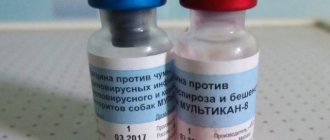The causes of gastritis in dogs and humans are similar.
The difference lies only in the frequency of occurrence of the disease and the form of its course. Despite the rarity of this diagnosis, most four-legged pets go to the veterinarian for examination in a very serious condition. The thing is that they cannot tell their owners about their illness. Because of this, the disorder is detected only at the stage of the appearance of an extensive ulcer, when the pain from irritation of the mucous membrane becomes unbearable.
What is gastritis and what can it look like?
The pathology affects the gastric mucosa. As a result of an extensive inflammatory process, regeneration slows down, so fibrous tissue grows in place of the affected cells. It disrupts secretory function, deviating the acidity (pH) of gastric juice from its norm.
Low pH levels interfere with digestion and impair motility. The food that accumulates inside begins to rot, causing acute poisoning of the entire body.
The situation with elevated pH levels is no less dangerous. The formation of an overly aggressive environment leads to the dissolution of one’s own tissues. Erosion and ulcers form on the mucous membrane, causing internal bleeding and adhesion to neighboring organs.
In its symptoms, the disease resembles a gastric ulcer. In both cases, severe pain is observed. The difference lies in the periods of exacerbation. With gastritis, the pain is constant, but with an ulcer, its appearance is influenced by the time of year, day and feeding. Most often it reminds itself of itself in the fall, spring, at night and immediately after eating.
Therapy for gastritis
Treatment, with some exceptions, is carried out at home. The activity of dogs is not limited unless they are too weak. If the cause is another disease, for example, a parasitic infection, then appropriate therapy is necessary.
What are antibiotics and what are they?
Medicines are selected depending on the cause of gastritis:
- gastritis caused by the pathogen Helicobacter. For conservative treatment, Trichopolum and Amoxicillin are used, which are prescribed simultaneously. This combination enhances the properties of the drugs. Drug therapy involves the use of antacids to reduce acidity, gastroprotectors - agents that protect the mucous membrane from damage. Therapeutic course is at least 21 days;
If infected with Helicobacter bacteria, a course of antibiotics is prescribed
- eosinophilic gastritis. The sick animal is prescribed corticosteroids (“Prednisolone”) and immunosuppressive drugs (“Azathioprine”). For allergies, homeopathic products are sometimes effective;
- atrophic gastritis. With regular vomiting, drugs to enhance the motor function of the stomach (Metoclopramide, Cisapride), Erythromycin help;
- acute gastritis. In case of severe dehydration, the dog is sent to the hospital. For frequent vomiting, fluids and medications are administered parenterally (bypassing the gastrointestinal tract). Water is given only after one or two days. Gastroprotectors do not work in this form. In severe cases, Ranitidine or other H2-histamine receptor blockers are prescribed. Ringer's solution is administered using infusion injections. Anorexia and profuse vomiting are the cause of hypokalemia, and then a potassium chloride solution is used. If symptoms persist after 5–7 days of therapy, then chronic gastritis, a systemic disease, or unresolved contact with an irritant are suspected;
Treatment tactics depend on the cause of the disease
- chronic gastritis. Vomiting and diarrhea during an exacerbation period quickly dehydrates the body, which poses the greatest danger. Drink and food are given in the same way as for acute gastritis. If the diagnosis reveals a tumor, stenosis, foreign bodies, ulcerations, surgical methods are used. Frequent and profuse vomiting is stopped with antiemetics, for example, Chlorpromazine. Slow gastric emptying, duodenogastric reflux, pyloric stenosis are indications for the use of Metoclopramide. Synthetic prostaglandins accelerate the healing of the mucosa. Immunosuppressants are indicated if diet therapy seemed ineffective, glucocorticoids - in case of an immune-dependent form of pathology;
- lymphoplasmacytic gastritis. Mild to moderate illness can be treated at home. If the disease provokes severe damage to intestinal tissue, enteropathy and loss of protein, the animal is completely transferred to parenteral nutrition, then to a mono-diet. To support remission, a diet based on highly digestible foods with a limited number of nutrient sources is indicated. After the condition has stabilized, additional studies are carried out. Dehydration is eliminated with the help of Ringer lactate or its analogues. Drug therapy consists of prescribing corticosteroids. A positive result can be achieved with the help of homeopathic remedies.
Corticosteroids are used to treat allergic forms of gastritis
Common causes of the disease
All causes of gastritis in dogs are divided into primary and secondary. The first include feeding disorders, poisoning and injury, that is, external factors. The second group includes parasitosis and infections. In these diseases, inflammation of the mucous membrane develops as a complication, so its treatment cannot be done without eliminating the root cause.
Feeding disorders
Most often, the owner is to blame for the pet’s illness because he neglects feeding recommendations. The stomach of a quadruped can suffer if the following mistakes are made:
- Exceeding the daily feed allowance
. Consistent overfeeding leads not only to weight gain, but also to gastrointestinal pathologies. The incoming food does not have time to be digested, so the stomach stretches to store it.
- Regular consumption of prohibited foods
. Food from the human table is rich in spices and additives harmful to dogs. Also, the mucous membrane can be injured by sharp bones.
- Burning or hypothermia
too hot and cold pieces of food. The optimal temperature for food is room temperature.
- Abrupt transition to a new type of feeding
or for food of lower quality.
- Rare water change
or lack of filtering. By drinking stagnant water poured from the tap, the dog runs the risk of becoming infected with pathogenic microorganisms or being poisoned by harmful impurities.
- Wrong mode
. If the animal is fed whenever it has to, digestion is disrupted and cannot maintain cycles. An adult dog should be given food twice a day, at intervals of 12 hours.
Due to the variability of possible causes related to feeding, when preventing the disease, the main emphasis is on creating a safe and balanced diet.
Poisoning
In addition to spoiled food found in the trash, a dog can be poisoned by poison, household chemicals or medications. All potentially hazardous substances should be kept in a locked area away from the floor.
Stomach injuries
The mucous membrane can be injured when struck or swallowed by a sharp object. In addition to bones, any small objects, including parts from children's construction sets, pose a danger.
Parasitoses
Helminthic infestation is always accompanied by intoxication. The waste products of parasites negatively affect the mucous membrane, causing its destruction and inflammation.
Impact of infections
The main culprit of stomach inflammation in humans is infection with the bacterium Helicobacter pylori. This pathogen is less common in domestic animals. In most cases, the secondary cause is parvovirus infection, leptospirosis, distemper and adenovirosis. That is why they are vaccinated against all these diseases as early as 2-2.5 months.
How to reduce the likelihood of developing gastritis?
Remember that it is easier to avoid a disease than to cure it. Veterinarians have prepared several useful recommendations that will help avoid the development of gastritis in your pet. And the very first of them concerns the dog’s nutrition. To prevent stomach inflammation, select only high-quality food and do not give your pet food from the table.
Other prevention recommendations:
- Do not mix natural and industrial food. Decide what your pet’s diet will be, taking into account its individual characteristics.
- Keep a close eye on your dog while walking. She should not pick up unfamiliar objects or try to swallow them.
- Visit your veterinarian regularly. This is necessary for vaccination and anthelmintic therapy.
- Don't forget about hygiene procedures. An animal can bring pathogenic bacteria from the street onto its paws and fur.
- Never self-medicate or give medications from your home medicine cabinet. If you have any suspicious symptoms, contact your veterinarian.
Remember that the dog's health largely depends on your attention and care. Do not ignore the signs of gastritis - if you have any suspicions, contact a veterinary clinic and begin treatment!
Main signs and symptoms
The main sign of gastritis in dogs is vomiting. Because of this, the disease is often confused with poisoning or a cold.
Nausea is accompanied by lethargy and loss of activity. A sick pet refuses to play together and reluctantly goes out for a walk. With the onset of pain, he becomes irritable and aggressive. Such mood swings are easy to notice in good-natured animals who never snap at their owners.
Over time, appetite also disappears. Despite this, the desire to eat remains, but due to unpleasant sensations, most of the food remains in the bowl. Due to intoxication, severe thirst appears and the temperature rises.
More alarming symptoms appear only after a few days, when the mucous membrane receives significant damage. These include:
- significant weight loss;
- constipation or diarrhea (feces may contain undigested pieces of food or traces of blood);
- noticeable muscle tension in the abdomen (when touched, the patient grins threateningly, growls or whines);
- increased frequency of vomiting, changes in the color of the vomit to yellow or red, as well as regurgitation after each feeding;
- dulling of the coat;
- the smell of rot from the mouth and the appearance of a whitish or grayish coating on the tongue.
If you notice any of the above symptoms, be sure to schedule your pet for examination. Prolonged pathology is fraught with gastric volvulus and other dangerous complications.
Drugs
Almagel
It perfectly protects the gastric mucosa and is systematically prescribed for gastritis with an unlimited period of daily dosing two or three times a day.
Omeprazole
Neutralizer and blocker of excessive secretion of hydrochloric acid due to high acidity. Eliminates irritation of the stomach walls and normalizes the dog's bowel movements.
Trichopolum
The drug is relevant if gastritis is caused by the bacterium Helicobacter pylori. In this case, it is prescribed in combination.
Duphalac
A drug with a laxative effect. Can be prescribed for systematic constipation in an animal.
Erythromycin
It is prescribed only for bacterial etiology of the disease, regardless of the level of acidity. But it can be completely excluded in case of severe liver or kidney failure in the animal.
The rest are for people
Maalox, Ranitidine, Omez, Gastal, Phosphalugel, Festal, Mezim, Nifuratel, Allohol, Pancreatin, Bicillin, Sulfadimezin, Furadonin, ASD-2 fraction, Cholenzym and Panzinorm - another group of drugs to combat gastritis in people, which is often and successfully used by veterinarians.
If you have any of the above in your home medicine cabinet, after preliminary consultation with a veterinarian and the established dosage , the medicine can be given to a sick pet.
Veterinary
As for veterinary drugs, the most popular in the complex treatment of gastritis are: Veracol, Zoonorm, Bifitrilak, Lactoferon, Katozal and Liarsin.
Classification of pathology
Depending on the form of the course, the pH level and the root cause, the disease is divided into several varieties. They all have different treatments and prognoses, so don't try to deal with the problem on your own.
According to the flow form
Gastritis in dogs can be acute or chronic. In the first case, there is a clear clinical picture and a sharp deterioration in the condition, and in the second, a series of remissions and relapses. If treatment is delayed, the acute form becomes chronic, which significantly worsens the prognosis for recovery.
According to stomach acidity
When the pH deviates above the norm, the pathology is called hyperacid, and when the pH deviates below the norm, it is called hypoacid. If the acidity level remains within standard values, then the animal is diagnosed with normacid inflammation.
Due to the appearance
Another 5 types of disease are determined by its cause. These include:
- hypoxemic, developing with heart pathologies against the background of prolonged hypoxia (lack of oxygen);
- eosinophilic, diagnosed when eosinophils grow due to parasitosis and allergic reactions;
- endogenous, arising from vitamin and mineral deficiencies;
- uremic, appearing in liver diseases;
- lymphoplasmacytic, found in autoimmune disorders.
The pet may also be diagnosed with an idiopathic type. It is indicated when the exact cause of origin remains unknown even after testing. In this case, treatment is carried out according to the general scheme.
Owner stories
Ekaterina : “I have a Great Dane, 3.5 years old. When he was a puppy, there was either poor appetite or excessive increase in appetite. There is a high level of eosinophils. Due to diarrhea, I lost 4 kilograms. The veterinarian prescribed Vetom, Trichopolum and Linex, as well as a strict diet and Intestinal food, which was not suitable. Now we are injecting with Actovegin, drinking Festal and Acidin-pepsin. The doctor speaks about the presence of atrophic gastritis. He suggests doing an ultrasound and a detailed stool analysis. It is necessary to visualize the lymph nodes and evaluate peristalsis.”
Inna : “My terrier is two years old. From the very beginning, he periodically vomited and had yellow saliva. At the same time, the chair is often unformed. The veterinarian advised me to change the food. We chose Royal Canin for allergy sufferers.
The dog switched first to oatmeal, and then to rice with finely chopped beef. There was no more vomiting, the stool improved. I asked the veterinarian what can be given in this situation. He replied that it was better to stick to meat and rice porridge. He advised introducing boiled vegetables. If there is severe vomiting, you can give Almagel or Phosphalugel in suspension. The doctor said to give the medicine two times a day before meals in the amount of one and a half milliliters.”
Video
Conclusion
Therapy for gastritis can last a long time. This requires money and patience. Remember that neglected disease has the most serious consequences. Do not seek treatment on your own. A sick animal should be taken to a veterinarian immediately .
What tests need to be taken for diagnosis?
To make a diagnosis, you will need to undergo urine and blood tests, ultrasound, x-rays, biopsy and endoscopy. Based on the results of these studies, the doctor will be able to determine the source of the disease, the condition of the mucous membrane, the level of acidity and associated disorders.
In what cases is it necessary to urgently contact a veterinary clinic?
If gastritis starts, it becomes chronic. At the same time, in the lower part the wall of the stomach thickens, blockage and food retention occur. This disease often appears in small breed puppies.
Chronic gastritis manifests itself in the form of constant vomiting, lack of appetite, unpleasant odor from the mouth, and pain in the epigastrium. If at least one symptom is detected, it is necessary to promptly show the dog to the veterinarian.
Important! Gastritis can develop into a stomach ulcer.
Therapy prescribed by a veterinarian
Drug treatment of gastritis in dogs is carried out at home. Hospitalization is recommended only for those who cannot feed themselves due to frequent bouts of vomiting.
The list of medications used is selected individually based on the cause of the disease and its symptoms. Most often used:
- anti-ulcer to lower pH levels;
- anthelmintics and antibiotics;
- antacids with an enveloping effect;
- immunomodulators and vitamins;
- antiemetics;
- digestive enzymes;
- antispasmodics and analgesics;
- antihistamines and glucocorticosteroids that suppress allergic reactions and the immune response;
- laxatives or fixatives;
- hemostatic.
Folk remedies include St. John's wort, blueberries, oak bark and flax seeds. Decoctions from these plants make it difficult to absorb toxins and protect the nerve endings of damaged tissues.
Classification of gastritis in dogs (types and types)
First of all, veterinarians divide the forms of gastritis into acute and chronic . The first type is characterized by severe symptoms, rapid progression and development; as a rule, it is treated simply because it is easily detected.
Chronic gastritis is a long-term, slowly developing disease that rarely makes itself felt. Its symptoms are vague, atypical, difficult to treat and often lead to serious complications.
Diseases are also divided according to the composition of the acidic environment, pathogens and general origin.
Hyperacid, hypoacid and anacid types
The classification of gastritis according to these three points is due to the acidity and general composition of the stomach environment - its juice.
- The first case is characterized by a significant increase in acidity (which leads to constipation, severe pain and irritation of the walls of the organ).
- In the second, acidity is neutral and does not matter in the development of the disease. In the case of the Anatonic form, the enzymes do not contain hydrochloric acid, which is why the food is poorly processed or not digested at all.
Erosive form
Often appears due to stress (especially in pets living in the city) or due to treatment with low-quality medications. During this form of the disease, ulcers appear inside the stomach, which can bleed and grow into large wounds. It occurs due to the excessive activity of digestive acids, they destroy the walls of the mucous membrane that produced them.
A characteristic feature is blood clots or spotting in the stool, vomiting with blood, acute pain. The disease can be caused by injury or the entry of a solid object into the stomach cavity.
Eosinophilic form
A type of gastritis, the nature of which has not yet been studied. In the case of this disease, the stomach becomes overgrown with connective tissue, which creates thickenings and compactions in which eosinophils are found. These cells are aimed at fighting parasites, so, most likely, this form is caused by helminths. Although some scientists consider it an allergic manifestation.
A characteristic feature is severe bloating of the abdomen and stomach, vomiting due to obstruction of food.
Atrophic gastritis
This process is opposed to the previous one . The walls of the stomach become thinner due to increased acidity, as a result of which the mucous membrane ceases to secrete the required amount of secretions. Most often, the disease is chronic, caused by bacteria and autoimmune diseases. In 70-80% it leads to cancer (without proper treatment). It often appears in Laek representatives.
A characteristic feature is heartburn with severe pain and frequent belching.
Lymphoplasmacytic gastritis
A rare disease caused by an improper immune response to food. During development, lymph cells accumulate in the lining of the stomach, causing swelling and difficulty passing food. In terms of symptoms and sensations, this gastritis is similar to the eosinophilic form.
Basic principles of a therapeutic diet
Treatment is not complete without diet. Depending on the form of gastritis in the dog, the doctor decides what to feed it until it recovers. In case of chronic pathology, the diet must be adhered to throughout life.
Diet in acute form
The pet is deprived of any food for a day, and then gradually transferred to fractional meals. Before serving, all food is ground or mashed to a puree consistency. Dry granules are soaked in warm water or replaced with wet canned food. They begin to return to the usual menu on the 3-4th day, adding small pieces of meat to slimy porridges and starchy foods.
Diet for chronic form
Fasting is not practiced. The diet is less strict than in the acute form. The consumption of difficult-to-digest foods is excluded, but animal protein in the form of scrambled eggs and grated cheese is encouraged. All food is served boiled or stewed 3-5 times a day. Additional restrictions are imposed only if a relapse occurs.
Prohibited Products
The prohibited list includes any dishes from the human table and some products
:
- fatty meats and fish, as well as broths based on them;
- eggs (except egg white omelet);
- dry food;
- large bones;
- milk;
- sorrel, white cabbage, peas, turnips, mushrooms, garlic and onions;
- salty and spicy cheeses;
- fermented milk products with high fat content;
- millet, pearl barley and corn porridge;
- large bones.
Try to avoid overfeeding. Excessive production of gastric juice can aggravate the existing problem.
Allowed products and feed
Product safety is determined by pH level. If the value is low, it is recommended to eat bean puree, low-fat meat and fish broths, fermented milk products with low fat content, eggs and juices from beets or cabbage.
If the pH is higher than normal, then it is lowered to the desired value with watery porridges from rice and rolled oats, juices from carrots and potatoes, small pieces of lean boiled meat or fish.
When dry feeding, the animal is transferred to specialized food marked i/d. They reduce the load on the gastrointestinal tract and restore the intestinal microflora.
Is it possible to get rid of it completely?
The effectiveness of treatment depends too much on many factors. The age of the animal, its condition, and the presence of other concomitant or chronic pathologies play a role. It is also important whether gastritis developed secondary to one of the underlying causes.
Spicy
For example, timely and well-chosen therapy can eliminate the symptoms of acute gastritis within the first few days. And if at this stage the treatment is not stopped, but carried out to the end, both you and the dog will soon forget about the problem.
Chronic
But sluggish chronic inflammation with occasional exacerbations in some animals transforms over time into a variety of secondary pathologies: from dysbiosis to ulcers and oncology. The effectiveness of treatment in such situations can only be assumed based on the results of the established diagnosis of the complication that has arisen.
Lymphocytic-plasmacytic and others
In each specific case, the dog’s life expectancy, the duration of therapy, its maintenance and, in general, the possibility of treatment will depend on the severity of the secondary disease. The most dangerous in this regard are hemorrhagic, atrophic and uremic forms of gastritis.
Consequences and forecasts
Most often, complications arise in the chronic form, as it is always accompanied by relapses. Possible consequences include:
- tooth loss;
- alopecia;
- gastric hemorrhage;
- development of ulcers;
- deterioration of hearing and vision;
- intestinal obstruction;
- volvulus of the stomach.
Despite this, most cases of gastritis in dogs are treatable. An unfavorable prognosis is typical only in the presence of renal failure, as well as in the eosinophilic and lymphoplasmacytic varieties.
Prevention
Even if your dog is not included in the breed risk group, it is still important to prevent the development of gastritis. For this:
- The dog's diet must be balanced and consist of approved foods.
- Do not feed your pet “from the table”. Even if he asks. Find recipes for healthy dog treats or buy ready-made ones at a pet store if you want to please your pet.
- Annual vaccinations and periodic treatments against worms are the basis for the prevention of many diseases.
- It is important to monitor not only the correctness of the diet, but also the size of portions.
- Regular oral hygiene. Here we are not even talking about the fact that dogs also need to brush their teeth (which, of course, is very important). It is necessary to at least regularly examine your pet’s mouth, and if you notice any changes, such as inflammation of the gums, tooth loss or tartar formation, then you need to take the dog to the veterinary clinic for oral sanitation.
Don't forget that the mouth is part of the digestive tract.
Gastric volvulus as a concomitant pathology
Stable expansion of a full stomach is fraught with twisting. This pathology is accompanied by:
- severe anxiety;
- ineffective vomiting;
- increased salivation;
- bloating.
The only way to treat bloat is surgery. When visiting a veterinary clinic late, the likelihood of death from circulatory disorders and shock increases.
Symptoms of the disease
Chronic gastritis occurs without symptoms, with only occasional periods of exacerbation.
But the dog’s condition changes, even without clear signs. She becomes more lethargic, her coat becomes duller and her general appearance is unhealthy.
Main symptoms:
- pain in the abdominal area. The dog does not allow touching and whines. On palpation the peritoneum is enlarged;
- lack of appetite;
- apathy. The animal turns out to be from walks and entertainment. Ignores commands;
- vomiting, sometimes with blood;
- white coating on the tongue;
- severe thirst, most often in acute form;
- elevated body temperature.
Basically, the signs appear in aggregate.











